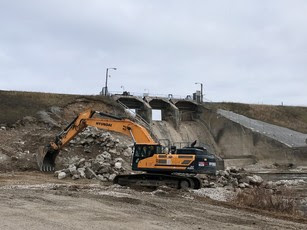MI Dam Safety Task Force Submits Report to Gov Whitmer; Cites Aging Infrastructure

If aging dam infrastructure isn’t repaired or funded soon, Michigan may face a significant and expensive loss of property and life- that’s according to the MI Dam Safety Task Force Report submitted to Governor Whitmer earlier today.
While the consequences of failing to fix or remove issues in the 1,1000 state run and 2,500 non-state run dams may seem like a lot, the report adds the risk dam failures can be reduced with long-needed improvements.
Liesl Clark, director of the Michigan Department of Environment, Great Lakes, and Energy says “Aging dams, just like all infrastructure throughout Michigan, suffer from a lack of consistent investment, which must be addressed if we want to avoid future tragedies.”
The report’s legislative, regulatory and departmental recommendations fall into seven categories:
- Funding for Dam Maintenance, Repair, and Removal: Develop a revolving loan and grant program to provide financing for maintenance that prioritizes risk reduction.
- Legislation and Authority: Revise and adopt laws and rules to clarify responsibilities and roles of owners and the engineers they hire, state agency personnel and federal entities; address land-use issues; raise public awareness and ensure owner accountability. Also, better communications and transparency is needed for sharing relevant dam information between the state and the Federal Energy Regulatory Commission (FERC).
- Improving Dam Safety: Require owners to meet their responsibilities through licensing, maintaining adequate financial security and setting aside sufficient funds for maintenance and ultimate removal of the dam. Also recommends requiring owners of high and significant hazard dams to have periodic independent comprehensive reviews by a qualified team.
- Compliance and Enforcement: Use state Dam Safety Program (DSP) resources efficiently through prioritizing portfolio-wide compliance and enforcement, and updating EGLE violation management policies.
- Emergency Response: Develop robust and integrated Emergency Action Plan (EAP) to address hazard emergencies.
- Program Management, Funding, and Budgeting: Suggests a proactive, risk-based approach by EGLE and DSP to manage and inventory the more than 1,500 dams the state regulates.
- Safety and Security at Dams: Develop and implement EGLE programs related to security, public safety and public awareness, such as public outreach and education initiatives, signage templates and enhanced public online interactive mapping tools.
- Outreach and Awareness: Schedule safety awareness seminars for internal and external stakeholders to develop a dam safety culture in Michigan. Target audiences would be state agency personnel, county officials, dam owners, floodplain managers and residents, legislators, consulting firms and tribal leaders.
Over the course of five months, the 19 members of the Task Force held 22 public meetings and workgroup sessions. The public had multiple opportunities and avenues to provide input and many of those comments are included in the report.
For a look at the full report, you can visit Michigan’s Dam Safety Task Force web page.



